
Easily Dye Pantry Staples for Fun and Simple Sensory Materials
Are you looking for fun sensory materials for your kid to play with? Do you have extra pantry items you could use? What about food dye? Over the years my daughters have thoroughly enjoyed using their dyed pasta in many ways including separating them out by color or size, pouring and transferring them between small containers, feeding the pasta to toy animals, driving toy vehicles through the pasta, and using the pasta in so many other different ways limited only by their imagination. Recently I dyed various white-ish colored pastas, beans, and rice using water-based food dye and I wanted to share these results with you in case you’re also interested in doing the same.
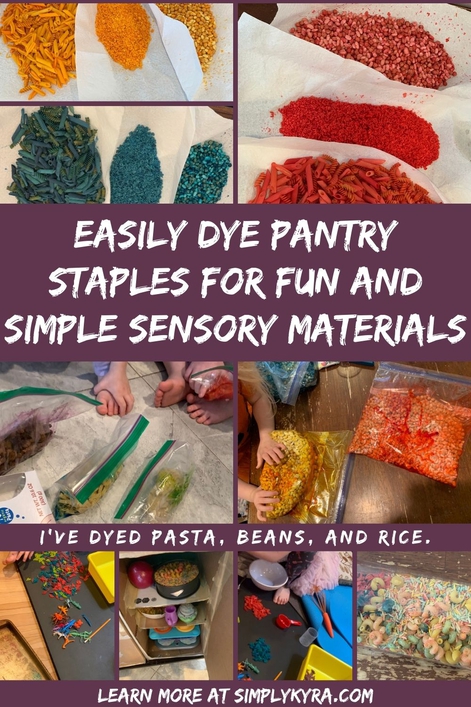
About a year or so ago I came across some dinosaur pasta at our local grocery store and I HAD to buy it for my kids. I used the first of the two boxes as a surprise in their tomato soup and then found myself left with the other unopened box. I wanted the dinosaurs to be enjoyed for longer than just one or two meals so I decided I needed to turn them into a sensory item so the kids could keep them around for longer and play with them whenever they wanted to. I remembered having dyed pasta a couple of years before and knew that dying these too was the way to go. The last time I dyed pasta; however, I used vinegar and ended up with splotchy colors so this time I first looked online, again, on how to dye pasta and decided to use the isopropyl alcohol I had on hand this time around and oh my goodness the colors were so amazing and haven’t started fading yet.
How I dye the pasta.
I had the girls help me dye the dinosaur pasta and we started out by deciding to use a four-pack of neon food dye rather than the three primary colors I normally work with. I grabbed four plastic sandwich bags to contain the dye and we quickly got to work laid out on the kitchen floor. Once we had everything laid out I started by pouring a quarter of the pasta into each bag before sploshing some of the 91% isopropyl alcohol in and then dribbling the dye over top. I then sealed the zip top of each bag before handing them off to my girls to mix up. At this point if the color wasn’t dark enough I could’ve easily added more dye and mixed it up some more. Once we were happy with the color we dumped the contents of the bag onto a paper towel lined cookie sheet to let the pasta dry. Looking back I think I used too much alcohol but it all turned out since the pasta stayed firm, the dye was set, and my cookie sheets ended up coming clean… over time. The kids had a blast with their new sensory toy and I still have these colorful dinosaurs contained in a plastic container in our sensory cupboard for whenever either girl wants to play with them again.
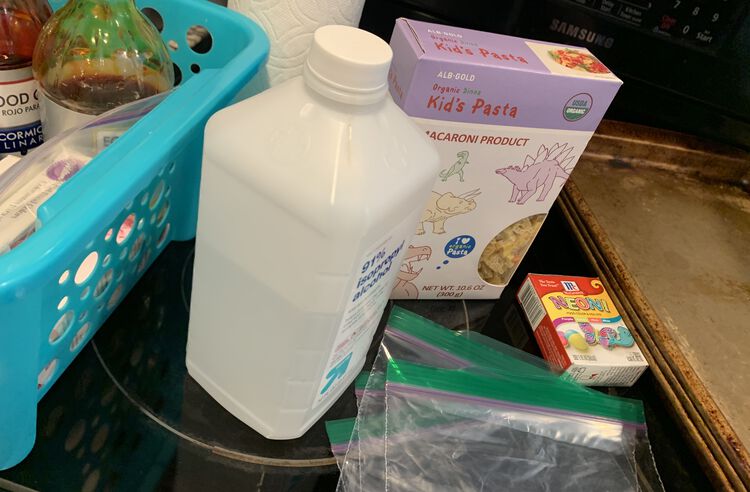
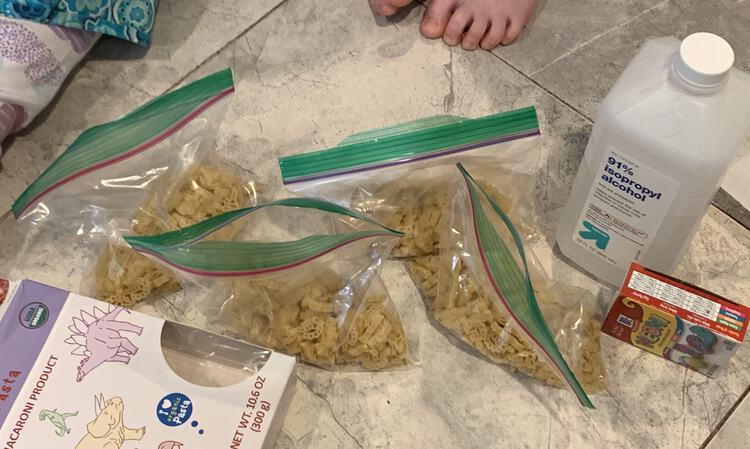
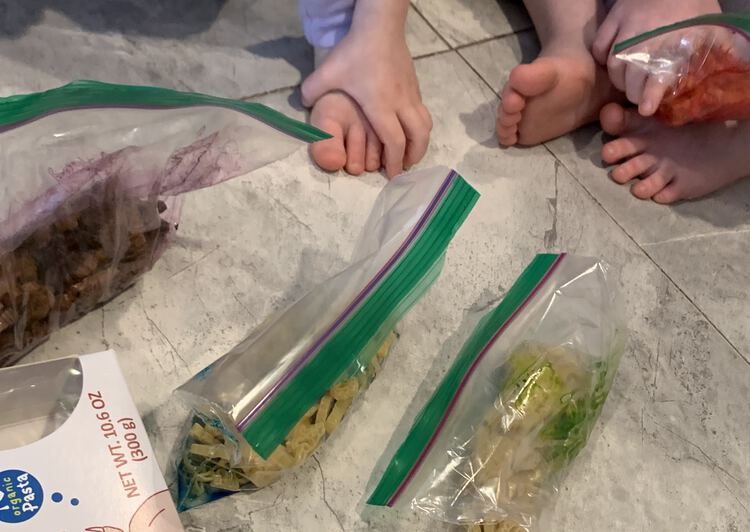
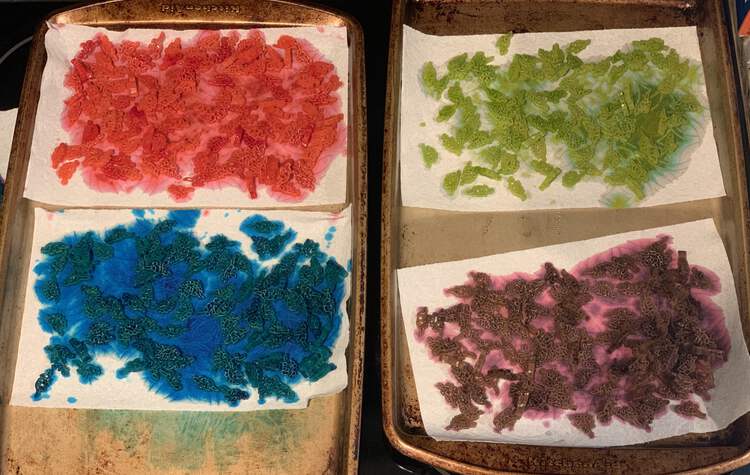
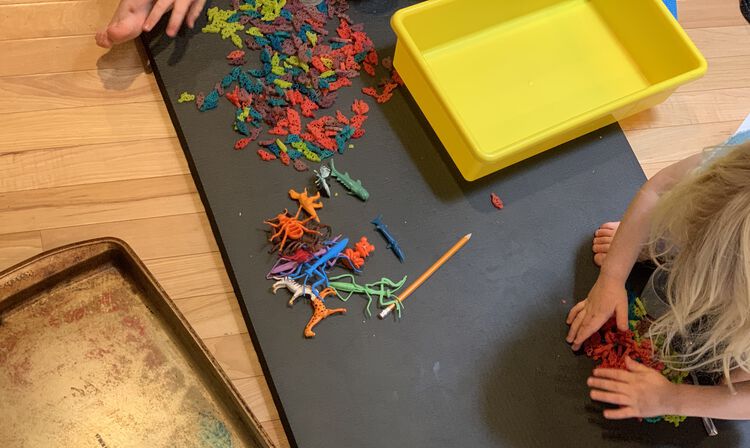
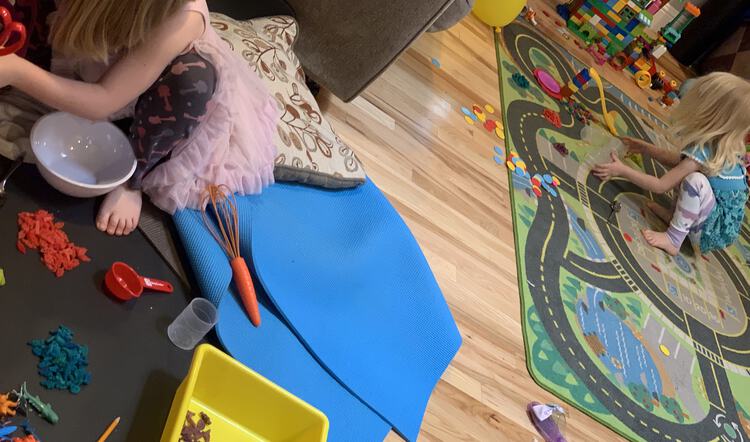
No isopropyl alcohol?
I prefer using isopropyl alcohol when dying pasta as it helps to coat each part of the pasta equally with the food dye, sets the dye so it doesn’t fade over time, and dries quickly. If you don’t have isopropyl alcohol on hand you could always use vinegar; however, I noticed the first time I dyed pasta using white vinegar that it ended up looking splotchy and several years later the same pasta is rather faded. Additionally the vinegar can make your pasta soggy if you use too much of it or are too slow dumping the pasta out to dry. I’ve also noticed a strong smell of vinegar lingering on my pasta for way longer than the isopropyl alcohol smells.
I came across a post by the Hair Bow Company back in 2015 that went over the difference between using vinegar and alcohol to dye pasta. I love the simple image she shared to show the difference between the two methods. She unfortunately didn’t go into what type of alcohol she used although in her conclusion she mentioned hearing of other people using “vodka… [which] seems like an expensive option to [her], but [she doesn’t] see why it wouldn’t work”. Looking further I noticed that The Parenting Chaos website mentions using rubbing alcohol so I then fell into the rubbing versus isopropyl alcohol search results and discovered, through Production Automation Corporation (PAC) that rubbing alcohol contains between 68% and 72% isopropyl alcohol and “[t]he remaining volume consists of water, with or without suitable stabilizers, perfume oils, and color additives certified by the FDA for use in drugs.” Additionally since “[i]sopropyl alcohol concentrations [of over] 91% volume have limited bactericidal efficiency and are less effective for antiseptic use [calling it rubbing alcohol] is not warranted and may cause confusion.” So I guess any alcohol should work to dye pasta whether you can drink it, clean with it, or anything. Heck I just found on Paging Fun Mums! that they used hand sanitizer to fix their dye which works perfectly if you bought too large of a bottle this year. If you don’t have any vinegar or alcohol of any sort and you still wanted colorful pastas you could look into changing your dying method and you might not need the vinegar or alcohol.
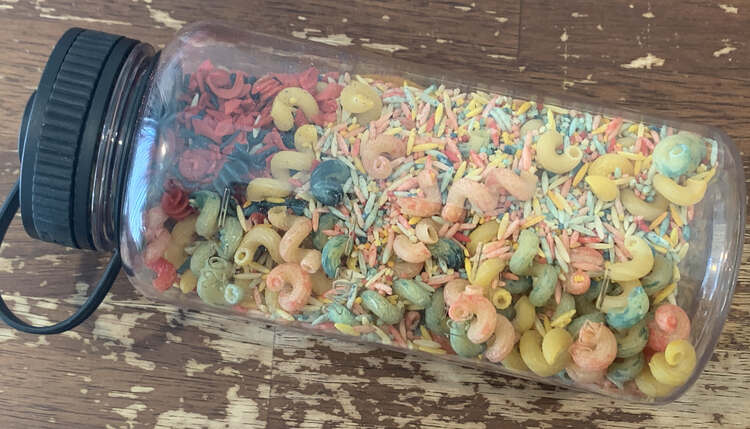
As an aside did you know what the specific difference is between ethyl alcohol and isopropyl alcohol (How Stuff Works) and that 70% alcohol cleans bacteria better than the 91% one (Apartment Therapy). Like I said I got pulled into the search results hardcore.
No water-based food dye?
I’ve only used water-based food dye when dying my pasta so far. That said I’ve seen people online using other methods to color their pasta. One simple way is if you use gel-based food dye instead. The Hair Bow Company’s Dyed Pasta: Alcohol vs. Vinegar, listed above, and the Happy Hooligans both used gel food colors along with the vinegar or alcohol. If you don’t have either form of food dye you could always use paint. Specifically Learn ~ Play ~ Imagine used liquid watercolors while The Imagination Tree used acrylic paint yet also said you could use tempera paint too. I also just came across Crafty Morning who colored her pasta with fun chalk markers and they turned out amazingly brilliant although I don’t how well the color is fixed to them if you wanted it for sensory play rather than art that just sits.
What else can you dye?
I thought of posting about dyed pasta after I set about making a bunch of dyed sensory materials for gifts this year. I wanted to offer a variety of materials so in addition to several different forms of pasta I also included dyed great northern beans, garbanzo beans, and white rice too. Essentially I think any light-colored items should work although I’m sure there may be exceptions to this. Before starting the dying process I thought of how the materials might be played with and decided to dye them in batches so they could be kept separate. I also knew that I wanted to keep the small pasta separate from the large ones as years ago when I dyed corkscrew pasta along with small pastas I realized the small ones kept getting jammed inside the corkscrews. I thus decided to dye the large flour-based and chickpea pastas in one batch, then added the small white rice to the small alphabet pasta, and then finally dyed both types of beans together. It was nice as I was able to keep reusing the same three bags as I made each batch.
Overall my process was the same as the dinosaur pasta although on a larger scale this time. I had decided to make the primary colors so I grabbed three large freezer bags and dumped about a third of each item into each bag. Once I had all the materials equally divided into the bags I sloshed isopropyl alcohol, this time 70%, into the bags and then about twenty or so large drops of water-based food dye. It was hard to count the drops so it may have ended up being much more as I counted to twenty while attempting to drop the dye in slowly. Overall it ended up being perfect although looking back I maybe should’ve dropped less dye in and then I could’ve always added more if I felt it required it. Anyway, after sealing each bag I gently shook it or squished it to mix it. Once I was happy with the dye distribution I opened the bag so it could start airing out while I prepped a surface for the material to dry on. As I was making essentially nine batches (three colors and three sets of material) I quickly ran out of cookie sheets. I ended up moving the first batch off of the paper towel lined cookie sheet by using the paper towel to move the entire pile and place it in an empty spot out of the way. I was then able to reuse the cookie sheet, with new paper towel, for the next batch. At one point I wasn’t sure how wet the pasta still was so I placed the paper towel wrapped pile on some scrap cardboard to protect my countertop from the dye and free my cookie sheet for the next batch. I was confident they were dry relatively quickly but I ended up leaving them overnight to be sure before packaging them up.
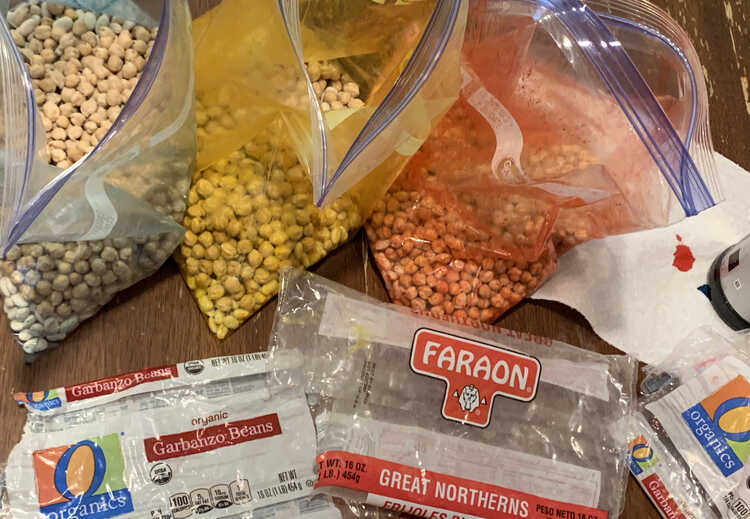
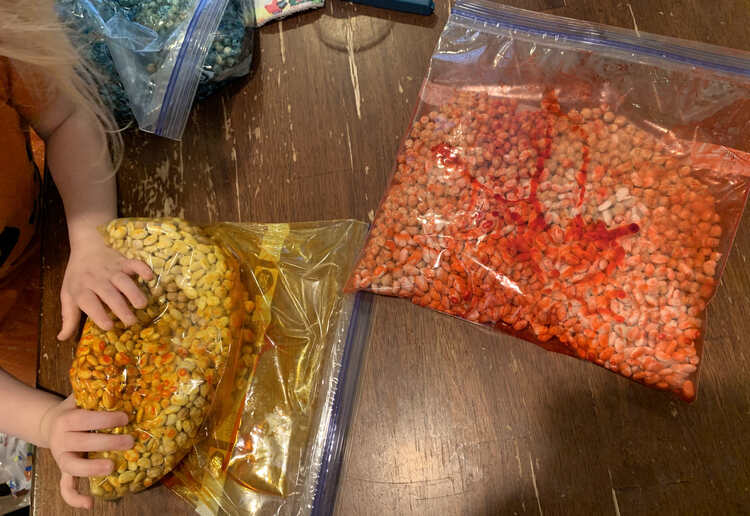
Once I was truly confident that all the batches had fully dried on their sheet of paper towel it was time to pack them up. I ended up bagging each type of material into a sandwich or snack-sized plastic bag with layers for each color. Any broken bits of pasta was thrown in with all of my old vinegar-dyed pasta which still smelled slightly like vinegar if I took a good whiff.
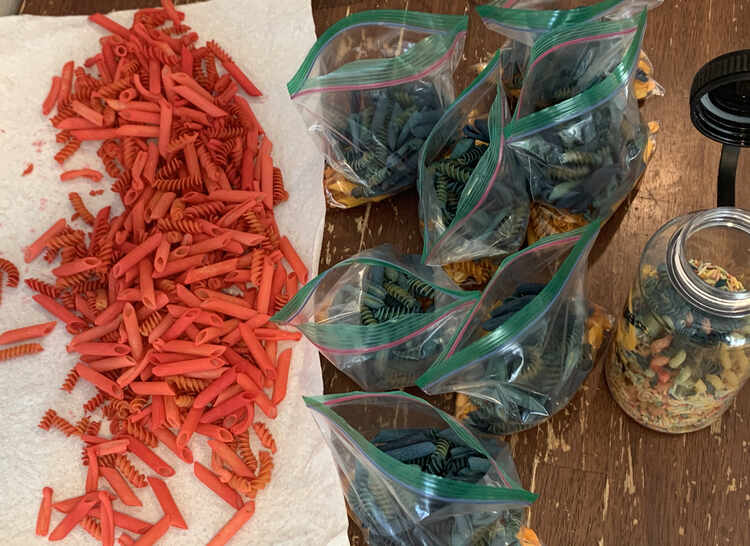
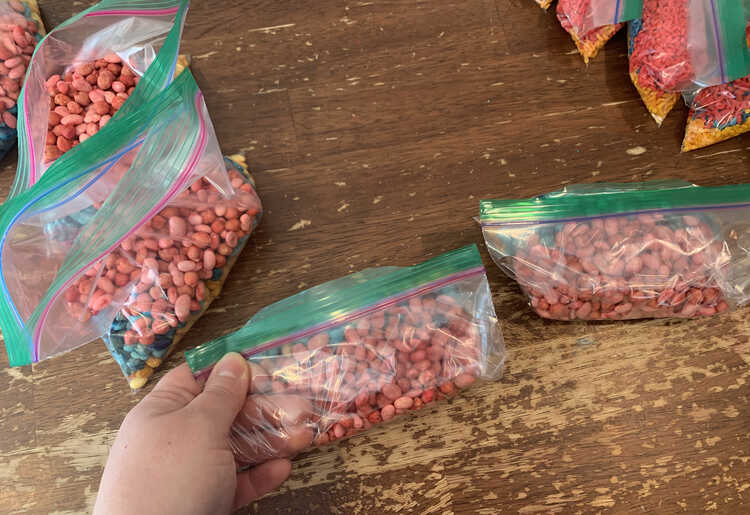
Comparing the colors and materials.
As I ended up dying nine batches of materials I figured I’d include some comparison photos in case you’re debating doing the same. All these materials were dyed using 70% isopropyl alcohol and water-based food dye. I didn’t measure how much dye or alcohol I used as it’s dependent on how much of the material you use and probably also on how porous it is.
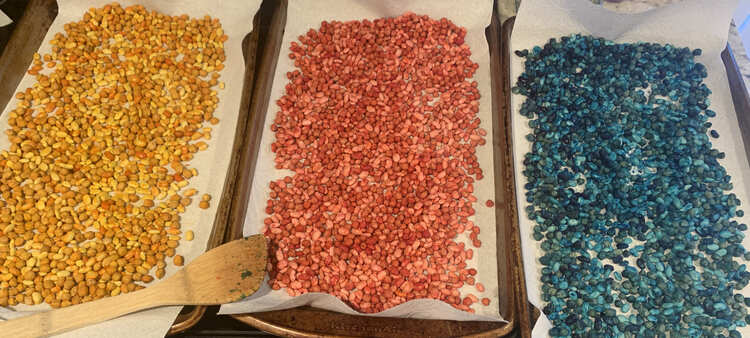
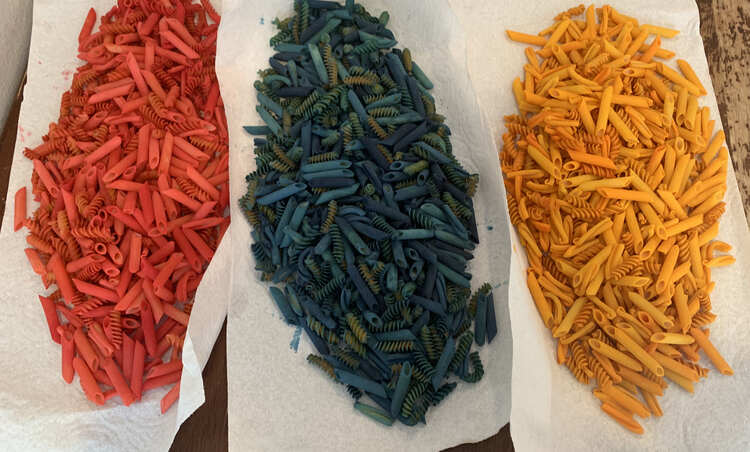
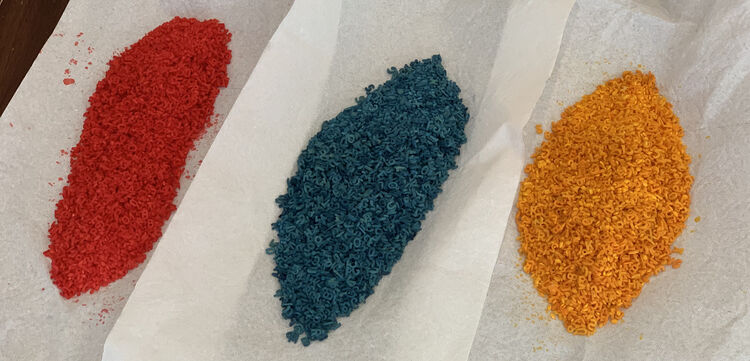
In case you wanted to compare the materials closer together I also separated them by color.
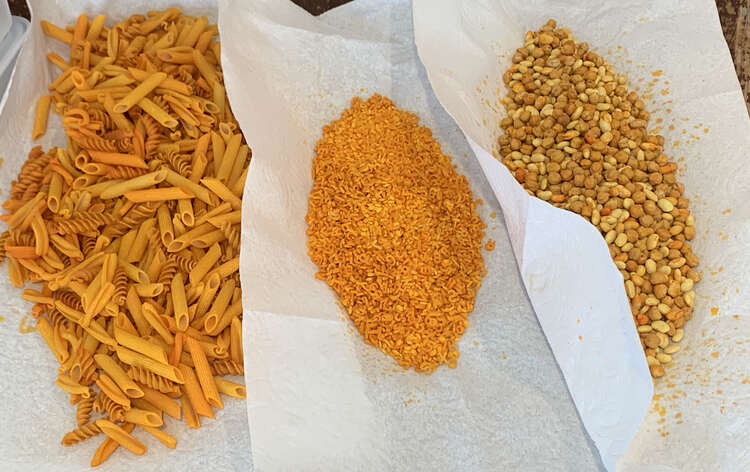
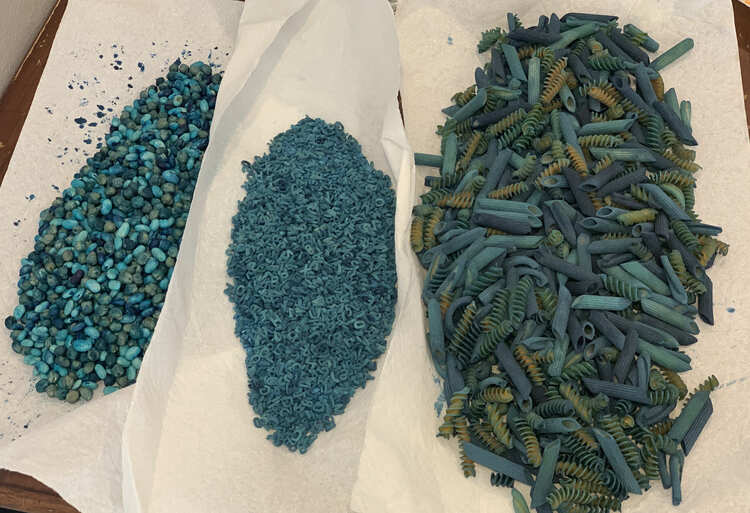
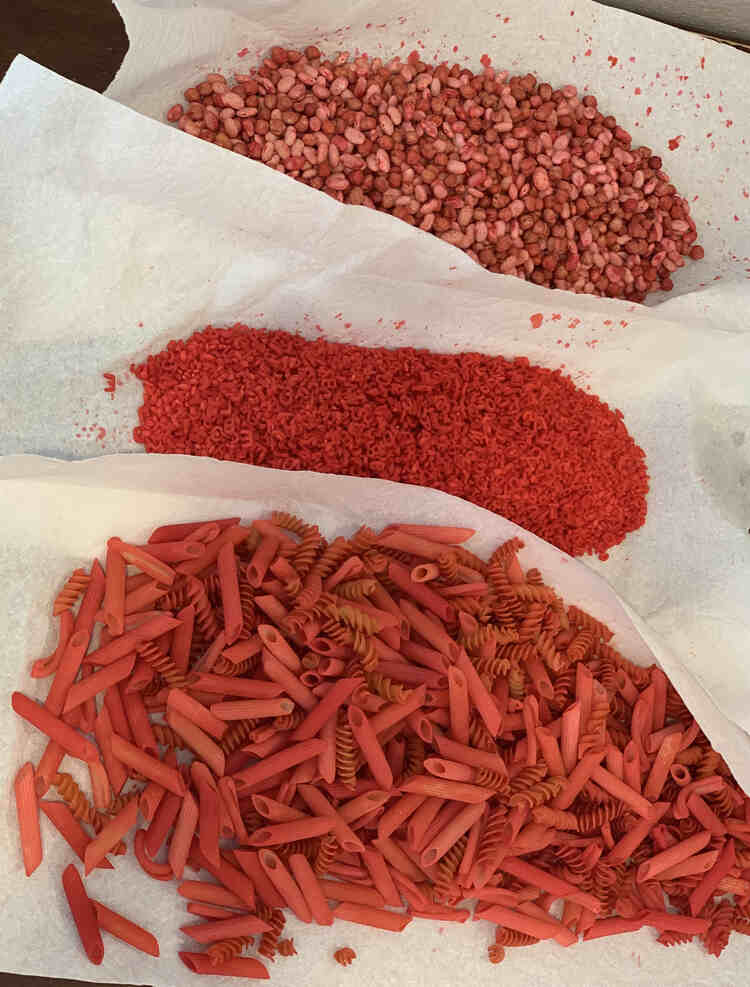
Can you eat it?
I wouldn’t recommend eating these pastas especially if you used isopropyl alcohol rather than vinegar. Plus I think boiling the pasta, so it’s more edible, would cause all the dye to come out. If you are looking to eat dyed pasta I found recipes through Tablespoon, delish, and Jenn’s Blah Blah Blog. I haven’t tried to make dyed edible pasta myself but it looks like all you need to do is boil your pasta until done, strain and shock it with cold water so it stops cooking, then divide it up into plastic bags or containers so you have a pile of pasta for each color you want to make. Then add food dye (one mentioned using water-based while the other mentioned gel-based) and some water to each bag or container, shake it up, and let it sit until the pasta darkens enough. Both delish and Tablespoon mention rinsing the pasta to take off the excess dye. Tablespoon has you plate the pasta with Parmesan clouds while Delish has you toss the pasta with butter, Parmesan cheese, salt, and pepper. None of the three articles mentions heating the pasta again so I’m not sure if you have to eat it cold or if you could microwave it first to warm it up.
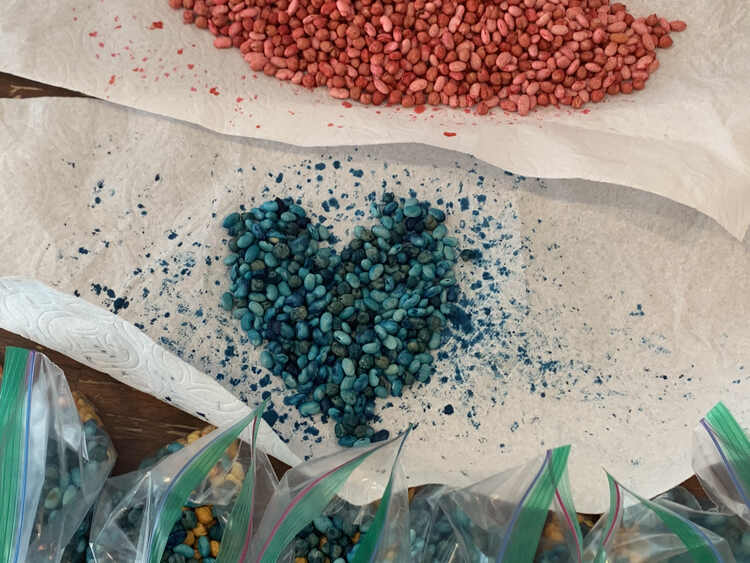
Have you dyed pasta or some other pantry material before? Are you planning on trying it out for your first time? I’d love to hear about your favorite materials to dye, your favorite dye, your favorite way to make art out of this, or how you have fun through sensory play with these dyed materials. Feel free to share any of these through the comments below. I truly hope your week is going well.
If you’re interested in getting any of my future blog updates I currently come out with a new one every Wednesday and share them to my Facebook page and Instagram account. You’re also more than welcome to join my email list located right under the search bar or underneath this post.

